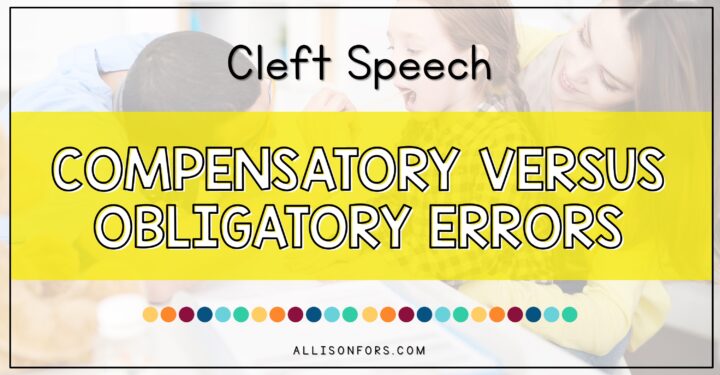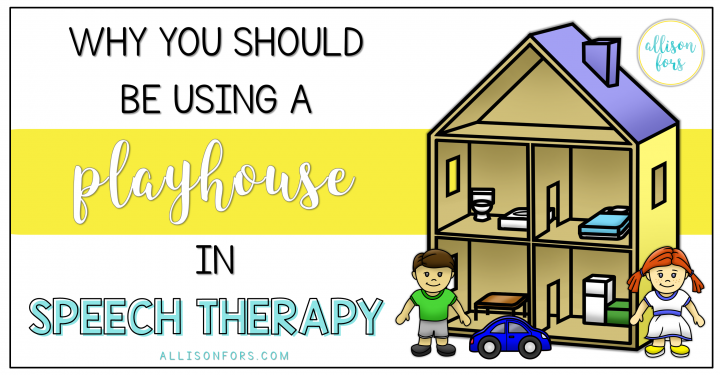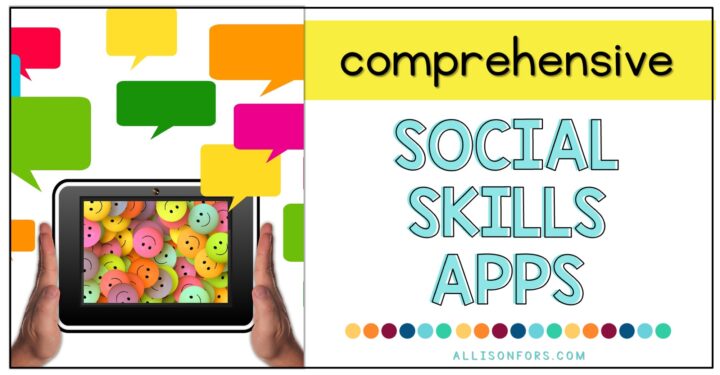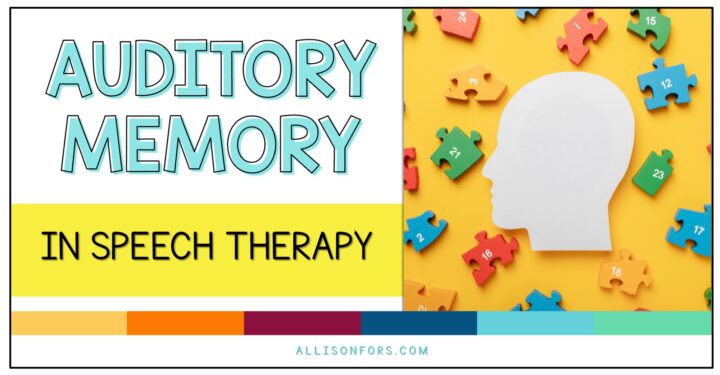
Why You Should Be Using a Playhouse in Speech Therapy
A dollhouse is one of my favorite therapy toys because it is versatile, functional, and engaging. I’ve used playhouses to work on many expressive and receptive language goals, as well as social skills. I prefer using a playhouse to target many of these goals as opposed to another toy because the vocabulary and language are what the child comes across on a daily basis. I have yet to find a child who doesn’t like to play with a playhouse – there are countless ways to play and adapt it to make it engaging!
There are many playhouses for purchase. I recommend getting one that has a family (mother, father, boy, girl) and rooms that are clearly defined (bathroom, kitchen) and comes with home objects (car, food.)
Download this graphic for free!
PRETEND PLAY/ROLE PLAY
Imaginary play is critical to development. Model pretend play if the child is not yet demonstrating these skills – pretend the baby is crying, the stove is hot, feed the doll food. Incorporate role play by being certain characters – pretend you are the mom giving the baby a bath, pretend you are the firefighter putting the house fire out. This is a great way to introduce new vocabulary and work on language in a functional way.
SOCIAL ROUTINES
Knock on the door. Demonstrate social routines between 2 dolls that the child may be having difficulty with. For example, show 2 dolls taking turns playing with a toy, then have the student be in charge of one of the dolls within the same routine.
TURN TAKING
Practice the social skill of taking turns. For example, you feed the doll then your student feeds the doll. This can be a sharing lesson or working on “my turn” or “your turn.”
CAUSE AND EFFECT
A critical part of development is a child realizing their actions have an effect on their environment – this aspect of language development comes before words. A favorite cause/effect game for every student is knocking the doll on the floor! Other examples include opening and closing the dollhouse door or activating any sounds if the dollhouse has that capability.
REQUESTING
Since playing with a dollhouse is motivating, it is a great way to coax a child to make requests. Present the child with the house but none of the doll/furniture pieces, so they need to request via non-verbal communication (signs, pointing) or verbal communication (single word, complete sentence), depending on their ability.
VOCABULARY
Work on functional vocabulary, for example, rooms of the house, household items, chores, family members, pets, etc.
RECEPTIVE IDENTIFICATION
Target identifying nouns, pronouns, verbs, prepositions, descriptors, and so much more! “Where is the boy?” “Who is sleeping?” “Where is the big car?”
NOUNS/PRONOUNS
Work on boy/girl, he/she/they, his/hers/theirs with the dolls. You can work on this expressively, “Whose chair is it?” or receptively, “Give her the chair.” I typically introduce these concepts with real people or real pictures, but I love using dollhouses to generalize and begin using nouns and pronouns in sentences and in conversation.
PLURALS
I use non-playhouse items with playhouses all the time! Grab more small toys to work on plurals (balls, more people, cars, food). Work on plurals with any item – 1 boy, 2 boys. Make sure you grab all regular plural items when starting out! Some irregular plurals you can work on: feet, teeth, people, men, women, children, shelves, knives, dresses, and houses.
POSSESSIVES
Possessives: my, mine, our(s), your(s), his, hers, its, theirs. During a play period, you can allocate certain dolls that belong to you and the child to work on “mine” and “yours.” To target “his” “hers” “theirs” “its,” give a doll or object an item, then ask “Whose cup is it?”
NEGATION
Negation can be a tricky concept to teach and learn! Examples of negatives include: no, not, never, none, no one, nothing, don’t, can’t, won’t. “Which doll is not eating?”
PREPOSITIONS
Work on spatial concepts such as in/out and on/off. Kids love to play the “where are you?” game – they cover their eyes while you place the doll somewhere in the house, then the child opens their eyes, finds the doll, and tells you where it was (under the bed, on the table.) They also love taking turns hiding the doll – once you find it, have them tell you where they hid it.
WH QUESTIONS
Work on “who” “what” “when” “where” “why” and “how” questions. I have found it is much easier to think of these types of questions when playing with a dollhouse versus other toys.
CATEGORIES
Have the child identify the category or list items in a category. Example categories: family members, rooms of the house, utensils, furniture.
ASSOCIATIONS
Work on “which things go together”. You can present the child with objects (plate, sandwich, ball) and have them select the 2 that go together and tell you why. You can also provide them with an object and have them tell you something that goes with it. This is easier since you don’t need to have all the items!
OBJECT FUNCTION
“What is a ___ for?” Talk about household items and their uses.
VERBS & VERB TENSES
Playhouses are great for action words. Have the dolls “walk”, “knock”, or “wake up”. Then work on present progressive verbs (walking) and past tense verbs (walked.)
MEAN LENGTH UTTERANCES
Incorporate expanding language while playing by modeling an additional 1-2 words based on what the child says. For example, if the child says “ball,” you can model “red ball,” “2 balls,” “kick ball,” or “I see ball.”
SEQUENCING
There are multiple aspects of sequencing you can target. You can have the child follow directions with sequencing terms (first/next/last). You can sequence home routines (how to brush teeth). And you can even work on higher-level sequencing by telling a story or demonstrating actions with the dolls and having the child retell or tell what happened in the correct order.
FOLLOWING DIRECTIONS
Provide directions for your student to follow. These can be basic 1-step directions “give me the doll” or more complex directions “put the boy on the bed and then close the door.” Incorporate descriptors, pronouns, prepositions, and temporal concepts (“Before you put the dad in the car, put the baby in the car,”)
ON-THE-GO PLAYHOUSE OPTIONS
APP: One of my favorite apps to use in therapy is called “MyPlayHome”
It’s a playhouse in a digital version! Perfect for traveling therapists or as an alternative. It is 100% worth the $3.99 price. If I were to spend money on only one app, this would be it!
You can check out a video of it here.
INTERACTIVE BOOK: I love playhouses so much, I created an Interactive Book version. It’s definitely a more portable, convenient option and a great way to expand language with adaptability on-the-go. This is one of my best sellers and for good reason.
You can see a video of it here!
I use all 3 of these playhouse options A TON to work on all the goals I’ve listed above. I hope this gave you some new, fun ideas to implement in your therapy sessions!
Thanks for reading!
Do you use a playhouse for therapy or your class? What else do you work on?
You may also be interested in:
Why You Should Be Using a Play Kitchen
Why You Should Be Using Wind-Up Toys












One Response
Great ideas! Thank for sharing!